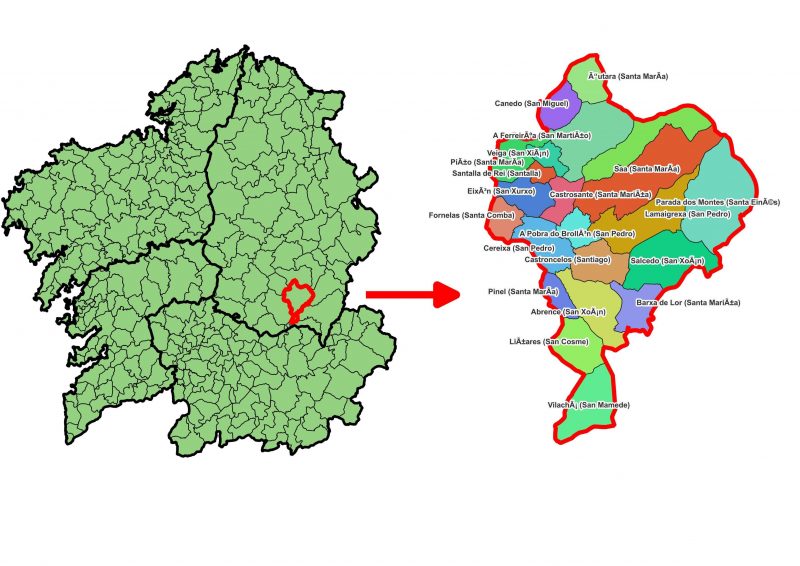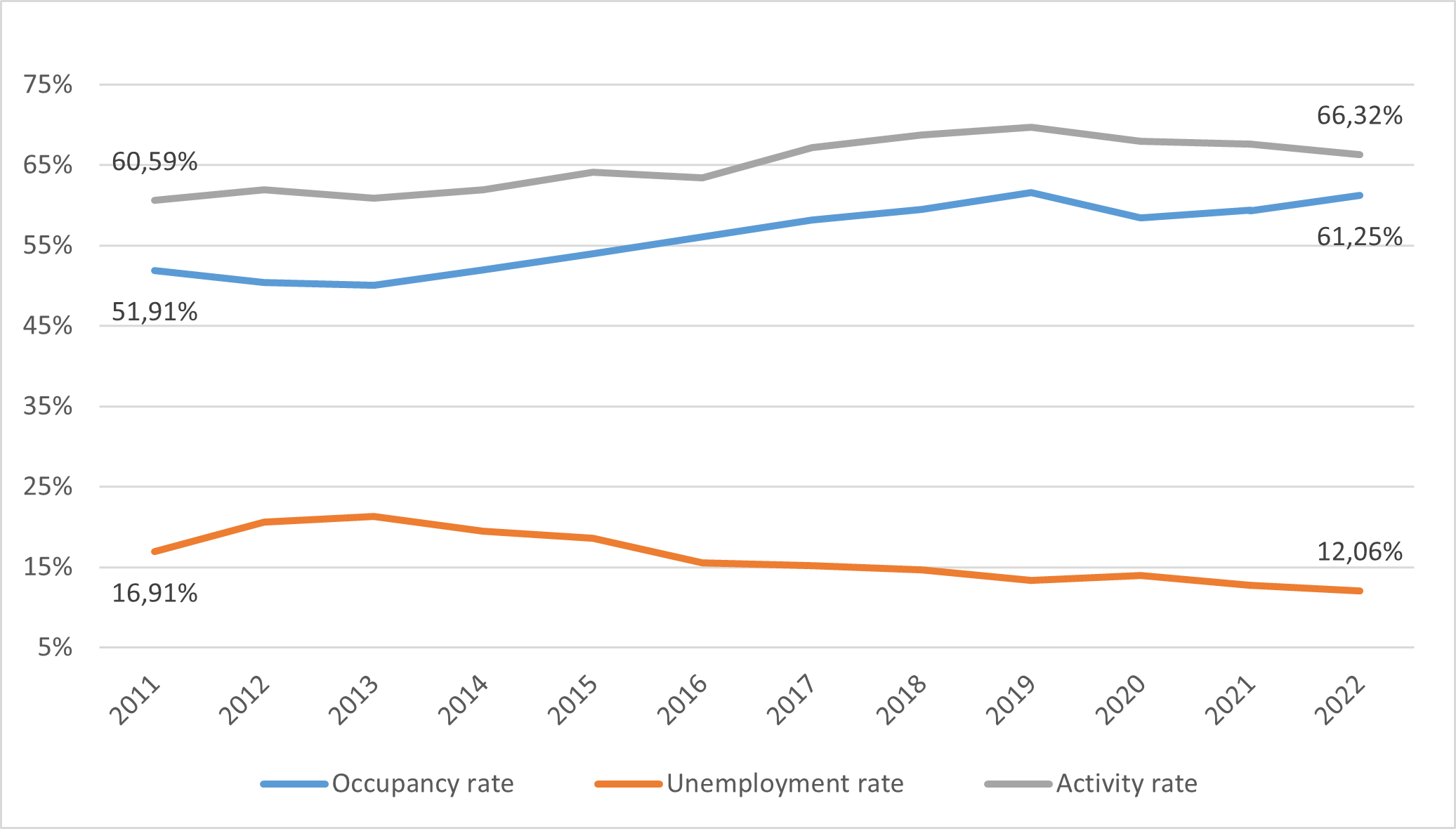
Introduction
The Municipality of A Pobra do Brollón is located in the region of Terra de Lemos, in the south of the province of Lugo and 60 kilometres from the provincial capital, it is a territory of 1,551 inhabitants in 2022, with a surface area of 176.71 square kilometres. It has a degree of urbanisation of Sparsely Populated Area, according to the Galician Institute of Statistics.
It is part of the Limia-Arnoia Rural Development Group (RDG6).

Population and demographic structure
The population of A Pobra do Brollón shows a steady decline in population from 1991 to 2022, with a decrease of 1,720 inhabitants. This figure represents a reduction of 52.6%, which corresponds to a loss of 56 inhabitants each year on average. This decline significantly exceeds the 1.5% declines recorded in Galicia and the 15.7% declines observed in the province of Lugo over the same period.
In the last decade, from 2012 to 2022, there has been a less pronounced population decline in Pobra do Brollón, with -21%, and in Lugo, with -7%, on the border with Galicia, with -3.3%. This phenomenon is linked to a general trend of population loss and a territorial demographic imbalance, especially evident in non-rural areas.
The demographic decline of the population of Brollón coincided with changes in population distribution, with a progressive deterioration of its population. Moreover, all age groups experienced significant declines between 2002 and 2022, with losses ranging from 30% to 55%, a trend that has slowed significantly in the last decade. The group most affected by population loss was young people under the age of 16, with a decline of 33%. The second most affected group was the working population, down 24%. The number of people over 64 years of age in the municipality fell by 17% to 150 people.
The demographic decline clearly reflects the narrowness of the base of the population pyramid and no perceptible thickening of the top, as well as an increase in the average age. In Pobra do Brollón, the average population of two inhabitants in 2022 will be slightly above the two 60-year-olds. Distinguishing by sex, the average age of men is 62 years, while the average age of two men is 59 years.
The Total Dependency Ratio (TDR) in A Pobra do Brollón reached its highest point in 2016, registering 113%, separating the Galician level from the provincial level, with 59% and 62.7% respectively. From this year onwards it began to fall until finally standing at 110.2% in 2022, while the Galician and provincial GDI stood at 62% and 65.8%. In short, in recent years we have observed an unfavourable trend characterised by an increase in the proportion of dependent people in relation to the population able to work, lower than that of the population aged 64 last year.

Population dynamics in A Pobra do Brollón.

Evolution of the total dependency ratio of A Pobra do Brollón, Lugo and Galicia.
Economy
The evolution of Gross Disposable Product (GDP) is similar to that observed in Galicia as a whole and in the province of Lugo. During the 2010s, growth rates oscillated between negative and positive values, with the period from 2014 to 2016 being particularly noteworthy, in which GDP increased by 7%. Subsequently, there was a reversal of trend, with negative growth rates continuing until the year of the pandemic. Despite this, it shows a fall in GDP of only -0.94% throughout the 2010s, in contrast to the -2% contraction recorded in Galicia and almost -4% in Lugo. In 2020, municipal GDP was 23.83 million euros.
Between 2018 and 2020, GDP contracted at all three territorial levels, registering a decline of -2.6% in Pobra do Brollón, well below the reductions observed in Galicia, with -7.7%, and Lugo, with -2%. Subsequently, Galicia showed a recovery of total GDP, with a growth of 10.5% until 2022.
The Gross Disposable Income (GDI) shows periods of notable growth throughout the period analysed from 2002 to 2020, mainly between 2002 and 2007, when the council increased its GDI by 19.5%, reaching a figure of 14,261 euros per inhabitant. From that point onwards, it fell in all three territories until 2014, when they marked a change of course and grew until the outbreak of the pandemic. In 2020, the per capita GDI in Pobra do Brollón stood at approximately 13,480 euros, registering a growth of 5%, compared to falls of 3% and 1.8% in Galicia and Lugo respectively. Overall, the municipality’s income increased by 13% during the period analysed, a growth higher than the 10% recorded in rural municipalities and 6.7% in urban municipalities.
Using the register of social security affiliations as an estimate of municipal employment, between 2011 and 2022, A Pobra do Brollón experienced a reduction of 12.4% in total affiliations, while at the provincial level there were hardly any variations and at the Galician level the number The number of memberships increased by 8%.
There was a significant decrease in primary sector affiliations in the municipality, in line with the reductions experienced at both provincial and autonomous community level. The primary sector in Pobra do Brollón lost 44.4% of affiliates, a reduction greater than that experienced in Galicia and Lugo as a whole, which was close to 20% in both cases. This sector is the productive sector with the lowest proportion of affiliations in the municipality, collecting 15.6% of these, similar to the 11.6% collected in the province of Lugo and higher than the small percentage of Galicia, with 5.2%.
The secondary sector also experiences a reduction of affiliations in the municipality, as is the case in Lugo, losing in both cases around 11% of affiliations, while in Galicia they are reduced by 3%. This sector has a very similar proportion in Lugo and in the municipality: around 18% of the affiliations, slightly below the 21% in Galicia.
The tertiary sector is gaining weight with an increase in the number of affiliates of 0.33%, a figure that is in line with the increase observed in Galicia as a whole, with 14%, and in Lugo as a whole, with 9.6%. In all three cases, this is the sector with the highest proportion of affiliations, representing around 70% of affiliations in the three territorial levels.
These results indicate that both the local and regional economies could have experienced less impact during the pandemic, thanks to the productive structure where the agri-food sector has a greater weight in the total number of affiliations, especially in the case of the municipality’s economy.
In 2022, A Pobra do Brollón had an activity rate of 61%. The unemployment rate in the municipality shows a gradual decline from 17% in 2011, which then increases to 21.3% in 2013 and ends at 12% in 2022. Throughout the period analysed, A Pobra do Brollón experienced a significant growth in employment and activity rates, significantly exceeding those recorded at both regional and provincial level. The employment rate in Pobra do Brollón shows a similar growth dynamic to that observed in the territorial groups: after reaching its lowest point at the beginning of the period, with 50%, it experienced a steady growth until 2019, standing at 61.6%. Although it experienced a slight reversal, it increased again to 61.2% in 2022, well above the figures recorded in Galicia and Lugo in the same year (47%).

Evolution of Gross Disposable Income per inhabitant in A Pobra do Brollón, Ourense and Galicia.

Evolution of employment, unemployment, and activity rates in the municipality of A Pobra do Brollón.
Energy resources
A Pobra do Brollón has an important energy infrastructure based on renewable sources, specifically hydro and solar photovoltaic. The installed capacity of hydroelectric energy is 1.558 MW in 2022. It also has approximately 601 kilowatts of solar photovoltaic energy installed. However, further diversification of renewable energy sources is essential to strengthen the municipality’s energy resilience and maximise its economic potential. The expansion of other forms of renewable energy, such as wind or biomass, would not only help to reduce dependence on a single source, but could also generate new economic and employment opportunities in the area.
The electricity consumption of A Pobra do Brollón in 2023 was 3,348.66 MWh. Residential consumption was 2,219.03 MWh. The consumption of services, including municipal services, was 831.40 MWh. Industry consumed 298.2 MWh.
Energy Policy Councils
Date of the first meeting:
27th May 2024
Number of participants:
30 people
Profile of participants:
- Staff of the municipality of A Pobra do Brollón: mayor
- EC4RURAL project staff: UVIGO, ESPAZOCOOP
- Citizens
Evaluation of the energy situation
A Pobra do Brollón has an important energy infrastructure based on renewable sources, especially hydroelectric and photovoltaic. The installed capacity of hydroelectric energy is 1.558 MW in 2022. It also has approximately 601 kilowatts of solar photovoltaic energy installed. However, further diversification of renewable energy sources is essential to strengthen the energy resilience of the municipality and maximise its economic potential. Developing other forms of renewable energy, such as wind or biomass, would not only help to reduce dependence on a single source, but could also create new economic and employment opportunities in the area.
Dialogue between the parties
During the meeting, there was an open dialogue between citizens and the municipality about photovoltaic energy production. There was a discussion which highlighted the following:
The reactivation and optimisation of under-utilised photovoltaic installations owned by the municipality was discussed. The spatio-temporal distribution of future photovoltaic panels was also discussed. The model of photovoltaic energy production with surplus energy (compensation and sale system, distribution system between partners…) and the feasibility of a community energy initiative in a place with such a dispersed population were discussed, with priority given to the model of surplus energy production for sale (commercialisation) through a cooperative. The advantages and challenges of promoting an energy community under the photovoltaic production model were discussed, linked to how to minimise the dependence of the energy community on the large energy distribution companies, the regulations, the level of maintenance of the investments and their amortisation period, the management of the different profiles and expectations of the people and entities promoting the project, the accompaniment in the process of maturing and launching the project. The governance model and the management of the energy community were also discussed. Finally, the financing models of a collective energy community initiative, managed by the prosumer promoters themselves, with equal contributions or in proportion to the consumption of the prosumer members, were discussed.
Conclusions
After the joint co-creative process, the first contact with the neighbourhood and local authorities have been positive. There is a real interest in the development of the rural energy community as they think about joint action and the benefits of making it happen.
As a final conclusion of this meeting, the Energy Policy Council has been created.



